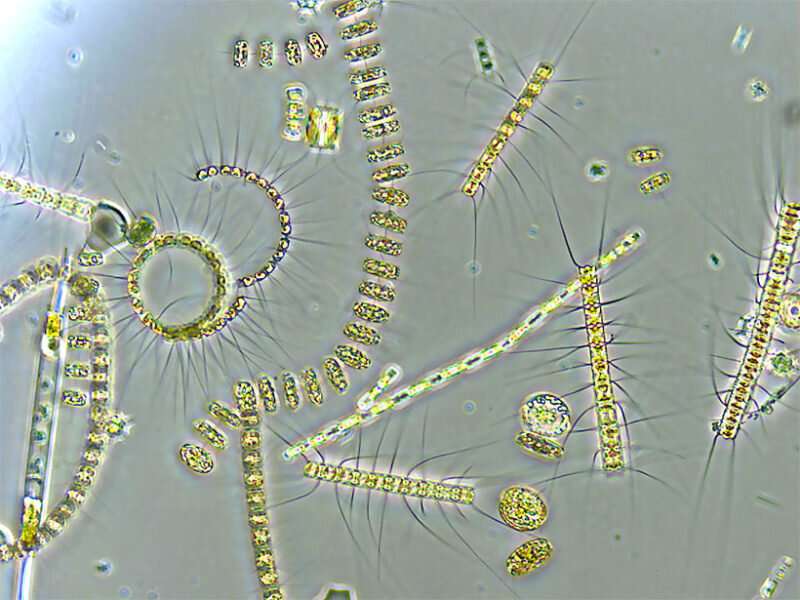Ocean ecosystems worldwide depend on single-celled photosynthetic organisms known as phytoplankton. A new study of ocean layers with the highest chlorophyll concentrations could lead to better understanding of these crucial creatures. Credit: NASA, University of Rhode Island/Stephanie Anderson
From vast, swirling blooms to minuscule populations, photosynthetic phytoplankton drifting near the surface of the ocean are often captured in snapshots from chlorophyll-detecting satellites. However, phytoplankton at greater depths escape detection, so researchers must rely on other methods to study them.
Now Cornec et al. present the first global-scale, direct-detection analysis of a key oceanic signature of subsurface phytoplankton populations: the deep chlorophyll maximum, which is the subsurface layer with the highest concentration of chlorophyll. A deep chlorophyll maximum can represent either a corresponding maximum concentration of phytoplankton biomass (deep biomass maximum) or an increase in the amount of chlorophyll found in each phytoplankton cell (deep photoacclimation maximum).
Previous research on deep chlorophyll maxima has focused on disparate ocean regions and seasons, with different studies applying different methodologies. Thus, much remains to be learned about the general processes that shape deep chlorophyll maxima, as well as their global-scale role in the carbon cycle.
The new study draws on data from a global network of more than 500 Biogeochemical–Argo floats to analyze the locations, types, and drivers of deep chlorophyll maxima around the world. The free-drifting floats contain a variety of sensors, including chlorophyll sensors, and they return data from varying ocean depths worldwide.
Analysis of the float data reveals that the dynamics of deep chlorophyll maxima are dependent on location and season. For instance, deep chlorophyll maxima are seen permanently or frequently in tropical and subtropical regions. Meanwhile, at high latitudes, they are less frequent and occur mostly in the summer in the form of deep biomass maxima.
In low-nutrient (oligotrophic) ocean regions, the analysis detected deep photoacclimation maxima that are permanent features but that are sometimes replaced by deep biomass maxima in the summer. Waters just north or south of equatorial regions appear to host permanent deep biomass maxima, thanks to abundant light and nutrients.
The analysis also suggests that availability of light in the upper layer of the ocean is the primary factor driving the development and depth of deep chlorophyll maxima around the world.
This study lays a new foundation for a better understanding of deep-ocean maxima phytoplankton and their role in the global carbon cycle.
More information: M. Cornec et al. Deep Chlorophyll Maxima in the Global Ocean: Occurrences, Drivers and Characteristics, Global Biogeochemical Cycles (2021). DOI: 10.1029/2020GB006759
Journal information: Global Biogeochemical Cycles
Provided by Eos
This story is republished courtesy of Eos, hosted by the American Geophysical Union. Read the original story here.






















